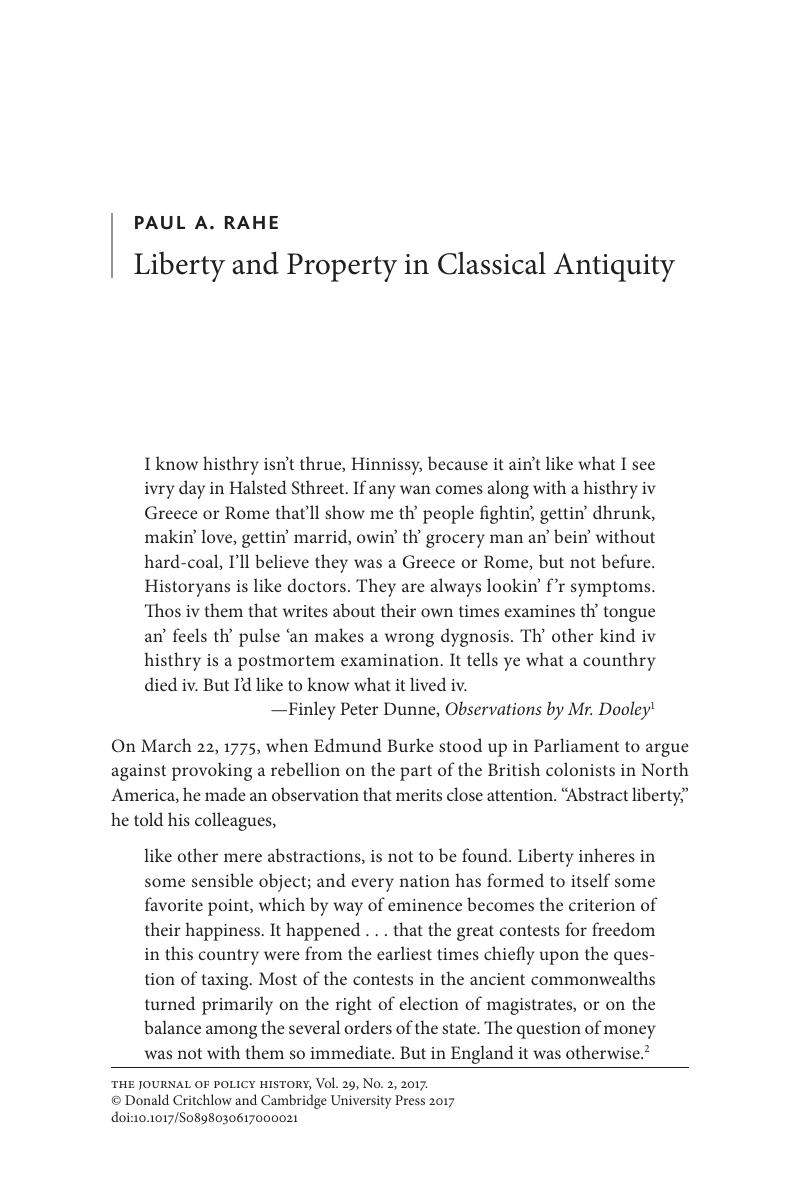No CrossRef data available.
Published online by Cambridge University Press: 14 March 2017

1. See Dunne, Finley Peter, Observations by Mr. Dooley (New York, 1902), 271.Google Scholar In the notes, I have adopted the standard abbreviations for classical texts and inscriptions provided in The Oxford Classical Dictionary, 4th ed. rev., ed. Simon Hornblower, Antony Spawforth, and Esther Eidinow (Oxford, 2012). Where possible, the ancient texts are cited by the divisions and subdivisions employed by the author or introduced by subsequent editors (that is, by book, part, chapter, section number, paragraph, act, scene, line, Stephanus page, or by page and line number). Unless otherwise specified, all translations are my own.
2. See Speech on Moving Resolutions for Conciliation with the Colonies, 22 March 1775, in The Writings and Speeches of the Right Honourable Edmund Burke (Boston, 1901), II:120–21.
3. See Max Weber, Economy and Society: An Outline of Interpretive Sociology, trans. Ephraim Fischoff et al., ed. Guenter Roth and Claus Wittich (Berkeley, 1978), II:1212–1372. Note also Max Weber, The Agrarian Sociology of Ancient Civilizations, trans. R. I. Frank (London, 1976), passim (esp. 147–220).
4. Montesquieu was the great exponent of this development, and in sharp terms he contrasted the martial republics of antiquity with the commercial republics of his own day: see Rahe, Paul A., Montesquieu and the Logic of Liberty: War, Religion, Commerce, Climate, Terrain, Technology, Uneasiness of Mind, the Spirit of Political Vigilance, and the Foundations of the Modern Republic (New Haven, 2009).Google Scholar
5. See Paul A. Rahe, Republics Ancient and Modern: Classical Republicanism and the American Revolution (Chapel Hill, 1992), II:260–520Google Scholar, and Against Throne and Altar: Machiavelli and Political Theory under the English Republic (New York, 2008), 245–46.
6. Franklin’s remark was made in passing at a dinner party on 7 April 1778: Boswell’s Life of Johnson, ed. George Birkbeck Hill (Oxford, 1887), II:245.
7. Karl Marx, Das Kapital: Kritik der politischen Ökonomie (Frankfurt, 1969–71), I:289 n. 13, 150.Google Scholar
8. Arist. Pol. 1252b27–1253a39. See 1278b15–30, 1280a25–1281a10, 1283b42–1284a3; Eth. Nic. 1097a15–1098b8, 1126b11–14, 1169b16–18. Note Pl. Leg. 4.707d, 6.770c–e; Eur. F48 (Nauck2).
9. Alcaeus F130.16–25 (Lobel-Page).
10. Theognis 173–78, 181–82 (West).
11. Xen. Hiero 7.3.
12. See Rahe, Republics Ancient and Modern, I:28–104.Google Scholar
13. Hybrias ap. Ath. 15.695f–696a.
14. Eur. F1019 (Nauck2).
15. Alexis de Tocqueville, De la Démocratie en Amérique 2.1.3, in Œuvres, papiers et correspondances, ed. J.-P. Mayer (Paris, 1951–2003), I:1–2.
16. See Phillip Brook Manville, The Origins of Citizenship in Ancient Athens (Princeton, 1990).Google Scholar
17. See Alexander Fuks, “Patterns and Types of Social-Economic Revolution in Greece from the Fourth to the Second Century B.C.,” in Fuks, Social Conflict in Ancient Greece (Jerusalem, 1984), 9–39.
18. Tocqueville, De la Démocratie en Amérique 2.1.10, in Œuvres, papiers et correspondances, I:1–2.
19. Arist. Pol., 1259a6–36.
20. In 1906, a palimpsest was discovered by a scholar of ancient mathematics named John Ludwig Heiberg in the library of the Metochion in Constantinople, in which this lost work was partially visible. Heiberg copied down what he could read and later published it. An English translation of what could be discerned was published six years later: Thomas Heath, The Method of Archimedes Recently Discovered by Heiberg: A Supplement to the Works of Archimedes, 1897 (Cambridge, 1912). The palimpsest disappeared soon thereafter and reappeared in 1998, was sold at auction, and was loaned to the Walters Art Museum in Baltimore for further study. Thanks to the use of x-ray technology and various forms of lighting, much that Heiberg and Heath could not read has now been uncovered: see The Archimedes Palimpsest, ed. Reviel Netz, William Noel, Nigel Wilson, and Natalie Tchernetska (Cambridge, 2011).
21. Plut. Marc. 14–17, 19.
22. Livy 24.34, 25.31.9–10. See also Polyb. 8.3–7, Cic. Fin. 5.50, Val. Max. 8.7 ext. 7. The tomb was still intact (though weathered) in Cicero’s time: Tusc. 5.64–66.
23. See G. E. R. Lloyd, Greek Science after Aristotle (New York, 1973), 91–112Google Scholar, and John G. Landels, Engineering in the Ancient World, rev. ed. (Berkeley, 2000), passim (esp. 26–31, 42–43, 71–81, 88–92, 99–105, 108–21, 127–31, 192–94, 199–208, 211, 227–28).
24. De rebus bellicis Praef. 6–7 (Ireland).
25. See Rahe, Paul A., The Spartan Regime: Its Character, Origins, and Grand Strategy (New Haven, 2016).Google Scholar
26. See Meiggs, Russell, The Athenian Empire (Oxford, 1972).Google Scholar
27. See Brunt, Peter A., Italian Manpower, 225 BC–AD 14 (Oxford, 1971)Google Scholar, and Claude Nicolet, The World of the Citizen in Republican Rome, trans. P. S. Falla (Berkeley, 1980).
28. Pl. Leg. 1.626a.
29. See Rahe, Paul A., The Grand Strategy of Classical Sparta: The Persian Challenge (New Haven, 2015), 130–326.Google Scholar